Abstract
Mycelial- or spherule-phase derivatives of Coccidioides immitis caused a decrease in vitro of total hemolytic complement in serum from a nonsensitized person. Activation involved both classic and alternative pathways as shown by deprssion of hemolytic C4 and by generation of products of activation of components C3, C4, and factor B. In addition, functional complement activity or immunoreactive levels of complement components or both were measured in 23 patients with self-limited or disseminated coccidioidomycosis. Low total hemolytic complement was found in nine, usually during the early phase of primary illness, and was transient. Hemolytic C4 was low, and the effect of inulin to decrease complement levels was blunted, suggested both classic and alternative pathways may be deficient. However, associated depression of immunoreactive levels of components assayed (C3, C4, C5, factor B, and properdin) was not consistently found. This disparity raises the possibility of enhanced in vitro inactivation analogous to activation by immune complexes.
Full text
PDF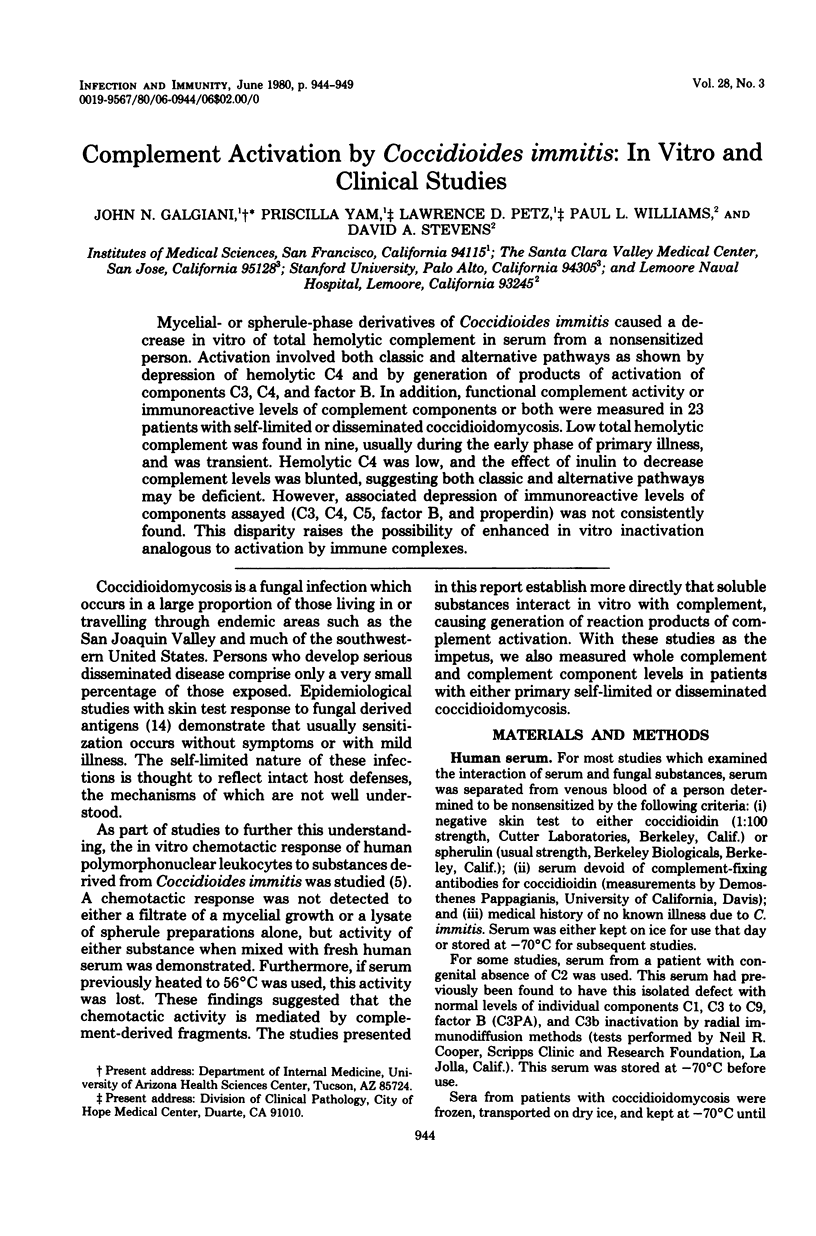
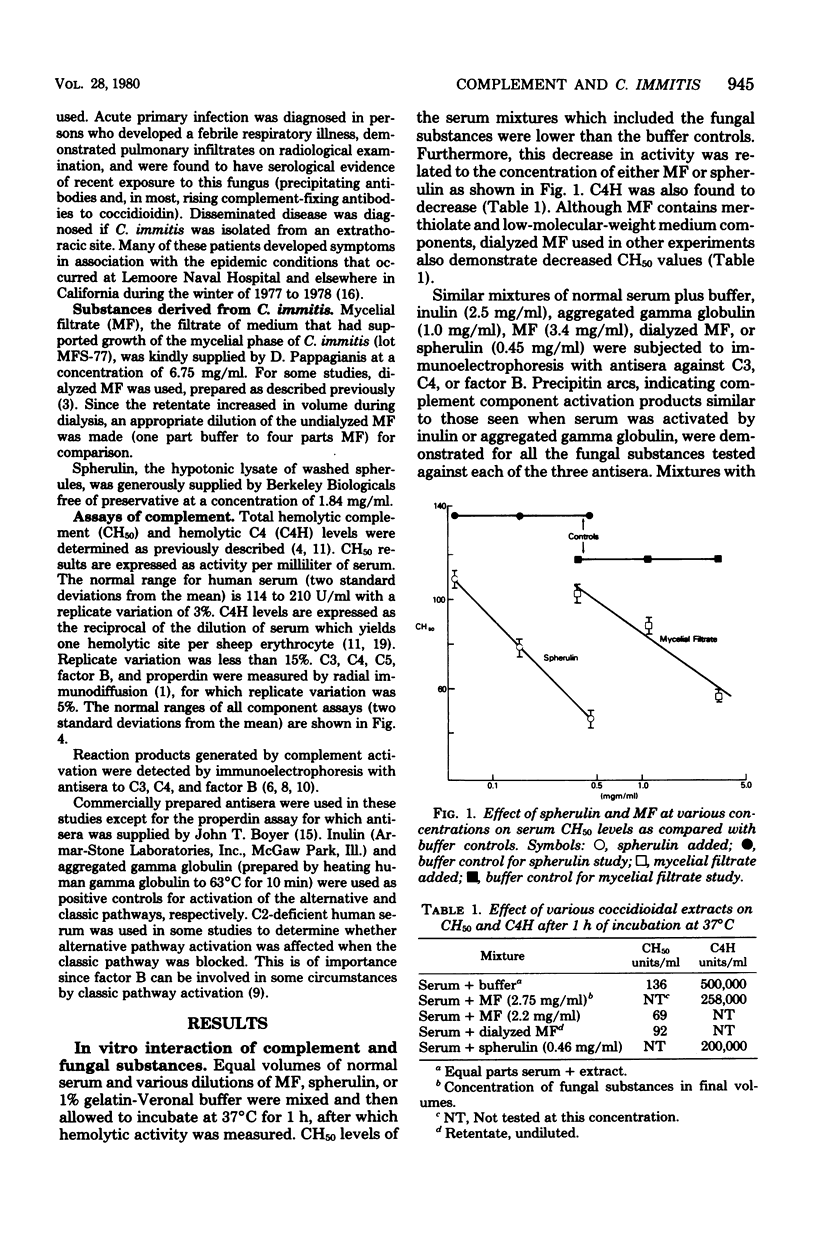
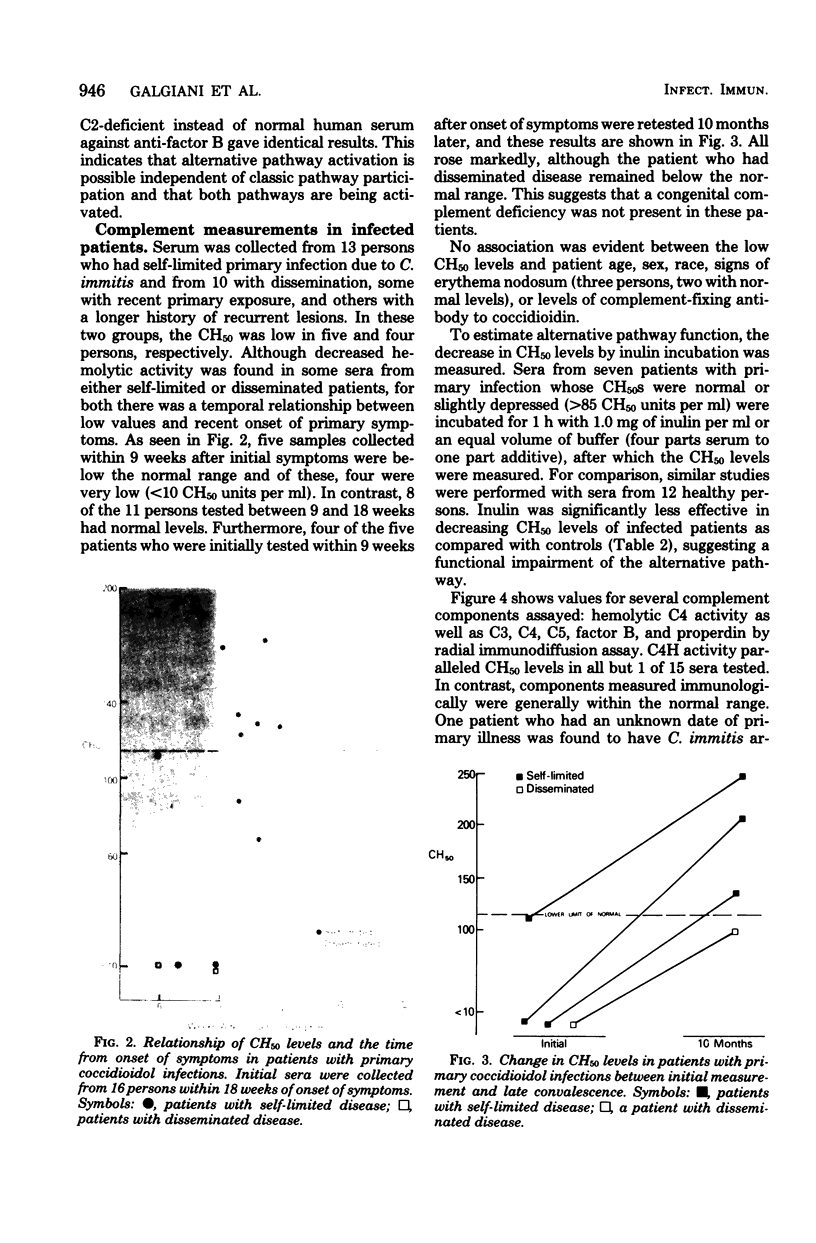
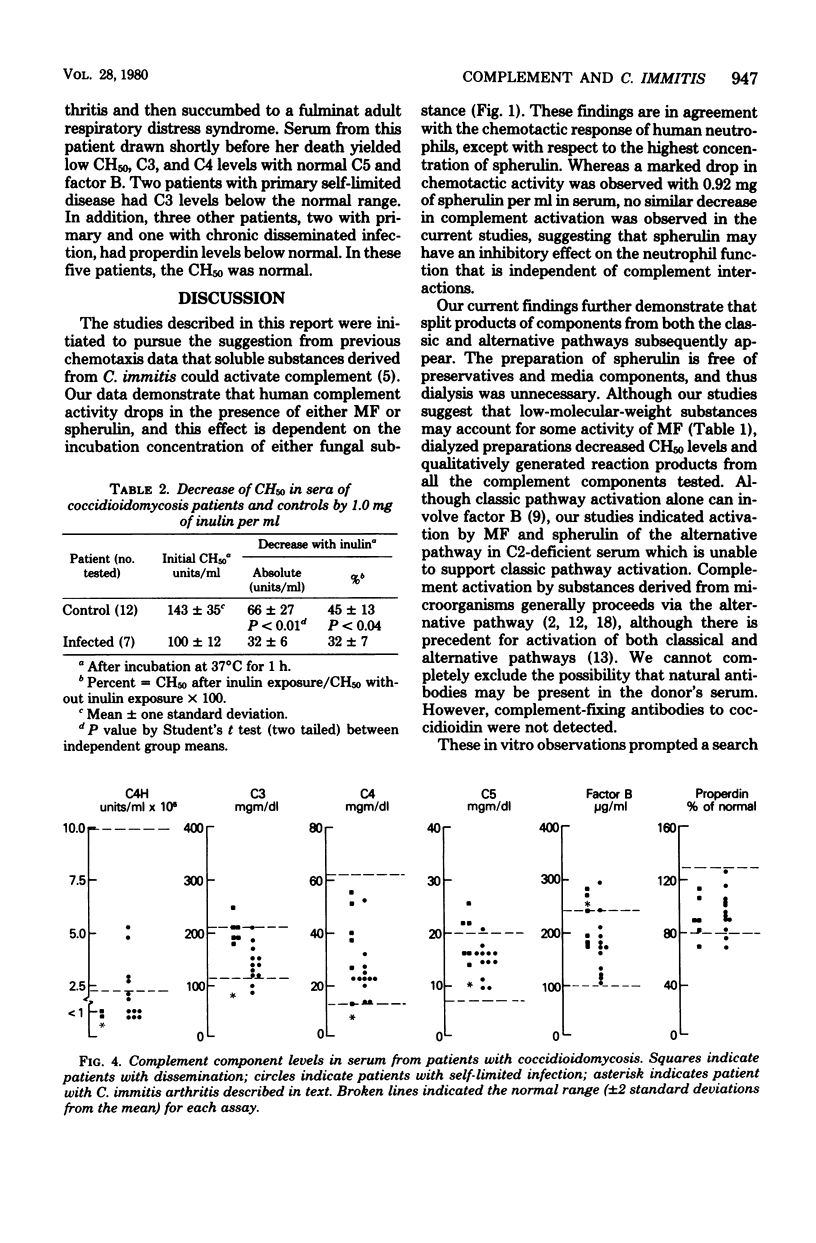
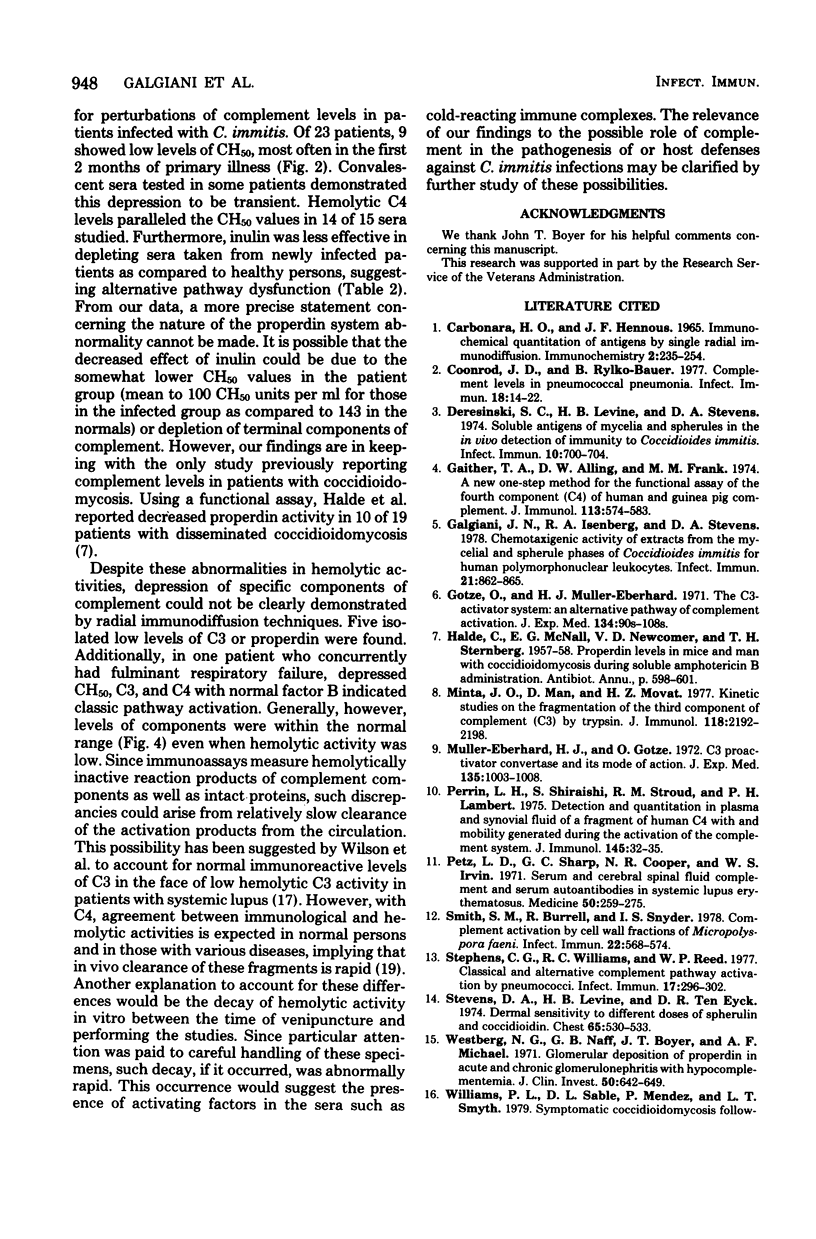
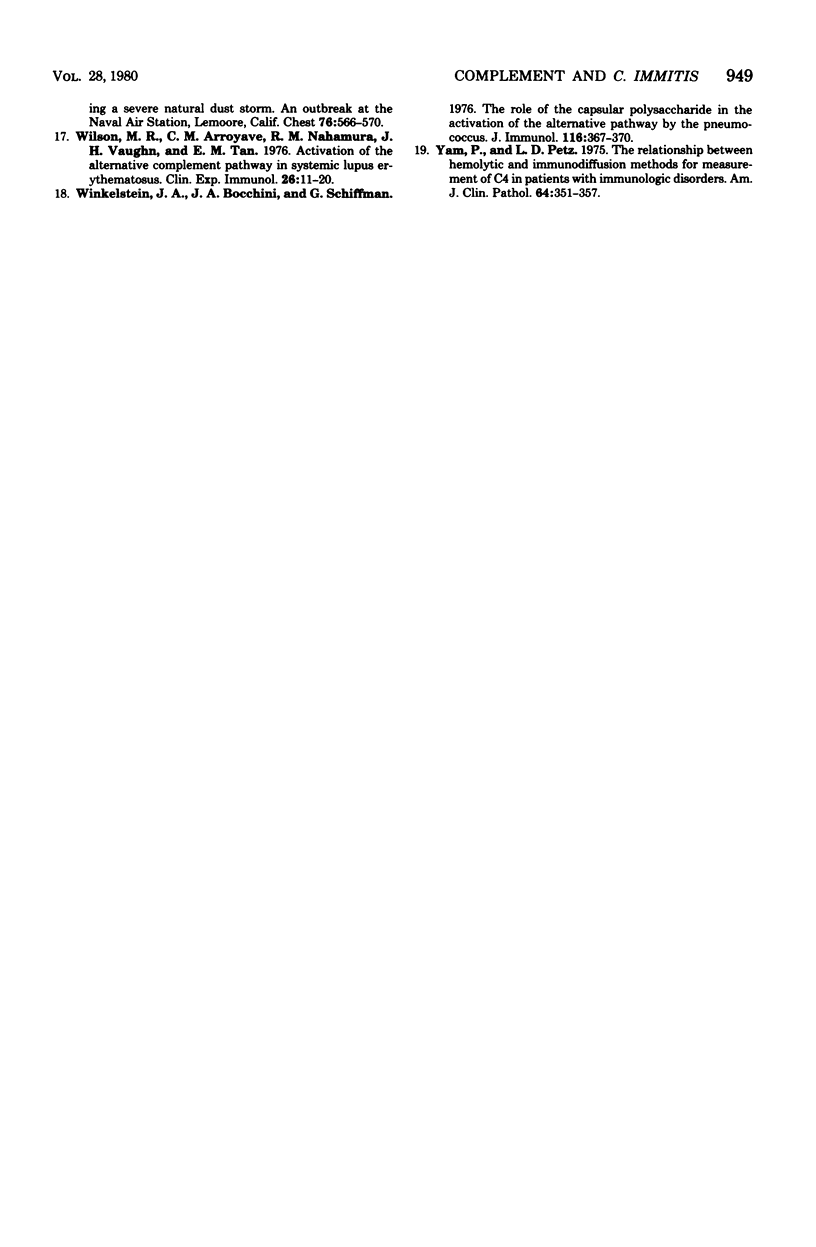
Images in this article
Selected References
These references are in PubMed. This may not be the complete list of references from this article.
- Coonrod J. D., Rylko-Bauer B. Complement levels in pneumococcal pneumonia. Infect Immun. 1977 Oct;18(1):14–22. doi: 10.1128/iai.18.1.14-22.1977. [DOI] [PMC free article] [PubMed] [Google Scholar]
- Deresinski S. C., Levine H. B., Stevens D. A. Soluble antigens of mycelia and spherules in the in vitro detection of immunity to Coccidioides immitis. Infect Immun. 1974 Oct;10(4):700–704. doi: 10.1128/iai.10.4.700-704.1974. [DOI] [PMC free article] [PubMed] [Google Scholar]
- Gaither T. A., Alling D. W., Frank M. M. A new one-step method for the functional assay of the fourth component (C4) of human and guinea pig complement. J Immunol. 1974 Aug;113(2):574–583. [PubMed] [Google Scholar]
- Galgiani J. N., Isenberg R. A., Stevens D. A. Chemotaxigenic activity of extracts from the mycelial and spherule phases of Coccidioides immitis for human polymorphonuclear leukocytes. Infect Immun. 1978 Sep;21(3):862–865. doi: 10.1128/iai.21.3.862-865.1978. [DOI] [PMC free article] [PubMed] [Google Scholar]
- Götze O., Müller-Eberhard H. J. The C3-activator system: an alternate pathway of complement activation. J Exp Med. 1971 Sep 1;134(3 Pt 2):90s–108s. [PubMed] [Google Scholar]
- HALDE C., McNALL E. G., NEWCOMER V. D., STERNBERG T. H. Properdin levels in mice and man with coccidioidomycosis during soluble amphotericin B administration. Antibiot Annu. 1957;5:598–601. [PubMed] [Google Scholar]
- Mancini G., Carbonara A. O., Heremans J. F. Immunochemical quantitation of antigens by single radial immunodiffusion. Immunochemistry. 1965 Sep;2(3):235–254. doi: 10.1016/0019-2791(65)90004-2. [DOI] [PubMed] [Google Scholar]
- Minta J. O., Man D., Movat H. Z. Kinetic studies on the fragmentation of the third component of complement (C3) by trypsin. J Immunol. 1977 Jun;118(6):2192–2198. [PubMed] [Google Scholar]
- Müller-Eberhard H. J., Götze O. C3 proactivator convertase and its mode of action. J Exp Med. 1972 Apr 1;135(4):1003–1008. doi: 10.1084/jem.135.4.1003. [DOI] [PMC free article] [PubMed] [Google Scholar]
- Perrin L. H., Shiraishi S., Stroud R. M., Lambert P. H. Detection and quantitation in plasma and synovial fluid of a fragment of human C4 with alpha mobility generated during the activation of the complement system. J Immunol. 1975 Jul;115(1):32–35. [PubMed] [Google Scholar]
- Petz L. D., Sharp G. C., Cooper N. R., Irvin W. S. Serum and cerebral spinal fluid complement and serum autoantibodies in systemic lupus erythematosus. Medicine (Baltimore) 1971 Jul;50(4):259–275. doi: 10.1097/00005792-197107000-00002. [DOI] [PubMed] [Google Scholar]
- Smith S. M., Burrell R., Snyder I. S. Complement activation by cell wall fractions of Micropolyspora faeni. Infect Immun. 1978 Nov;22(2):568–574. doi: 10.1128/iai.22.2.568-574.1978. [DOI] [PMC free article] [PubMed] [Google Scholar]
- Stephens C. G., Williams R. C., Jr, Reed W. P. Classical and alternative complement pathway activation by pneumococci. Infect Immun. 1977 Aug;17(2):296–302. doi: 10.1128/iai.17.2.296-302.1977. [DOI] [PMC free article] [PubMed] [Google Scholar]
- Stevens D. A., Levine H. B., TenEyck D. R. Dermal sensitivity to different doses of spherulin and coccidioidin. Chest. 1974 May;65(5):530–533. doi: 10.1378/chest.65.5.530. [DOI] [PubMed] [Google Scholar]
- Westberg N. G., Naff G. B., Boyer J. T., Michael A. F. Glomerular deposition of properdin in acute and chronic glomerulonephritis with hypocomplementemia. J Clin Invest. 1971 Mar;50(3):642–649. doi: 10.1172/JCI106534. [DOI] [PMC free article] [PubMed] [Google Scholar]
- Williams P. L., Sable D. L., Mendez P., Smyth L. T. Symptomatic coccidioidomycosis following a severe natural dust storm. An outbreak at the Naval Air Station, Lemoore, Calif. Chest. 1979 Nov;76(5):566–570. doi: 10.1378/chest.76.5.566. [DOI] [PubMed] [Google Scholar]
- Wilson M. R., Arroyave C. M., Nakamura R. M., Vaughan J. H., Tan E. M. Activation of the alternative complement pathway in systemic lupus erythematosus. Clin Exp Immunol. 1976 Oct;26(1):11–20. [PMC free article] [PubMed] [Google Scholar]
- Winkelstein J. A., Bocchini J. A., Jr, Schiffman G. The role of the capsular polysaccharide in the activation of the alternative pathway by the pneumococcus. J Immunol. 1976 Feb;116(2):367–370. [PubMed] [Google Scholar]
- Yam P., Petz L. D., Cooper N. R. The relationship between hemolytic and immunodiffusion methods for measurement of C4 in patients with immunologic disorders. Am J Clin Pathol. 1975 Sep;64(3):351–357. doi: 10.1093/ajcp/64.3.351. [DOI] [PubMed] [Google Scholar]



